Are you thinking of starting a WordPress web design business but still on the fence about it?
We know exactly how you feel. When we first started WPBeginner, many of our readers asked if we offered website design services. For years, we only provided free blog setup help and we wanted to focus on creating helpful WordPress tutorials.
However, as our expertise grew and demand increased, we launched our own WordPress website design services. This journey taught us valuable lessons about what it takes to build a successful web design business.
In this article, we’ll share essential tips for starting a WordPress web design business, based on our firsthand experience both as service providers and as longtime WordPress educators.

Is Starting a WordPress Design Business Worth It?
Based on our experience running WPBeginner Pro Services, the long-term potential of a WordPress web design business is very promising.
Compared to other types of businesses, the barrier to entry is lower. There are no expensive physical products or locations to manage. Since all the work revolves around WordPress, you can operate entirely online, eliminating overhead costs like office rent and utilities.
This flexibility also extends to your work schedule. You can be your own boss and set your own hours, just like we do with our team.
What’s more, WordPress is the most popular open-source content management system on the market, used by everyone from personal bloggers to enterprises to universities. So, you have a massive pool of potential clients to tap into, regardless of industry or business size.
In our experience, the initial hustle is definitely real. However, our goal has always been to help businesses succeed online, and we’re happy to see more WordPress professionals joining this mission.
Of course, there’s also the earning potential. Every agency is different, but from our knowledge of the industry, WordPress designers can earn upwards of $75 per hour. This translates to a potential six-figure income (around $156,000 annually) as you build your client base.
Before you start your website design company, there are several important factors to consider. We will look into the essential steps you need to take to turn your skills into a successful WordPress development agency in the following sections.
You can use the quick links below to navigate through this article:
- Decide on the Scope of Your Web Design Services
- Choose a Niche That Suits Your Strengths
- Create a Stunning Business Website With a Portfolio
- Figure Out the Best Pricing Strategy
- Make It Easy for People to Contact You
- Build a WordPress Plugin Toolkit
- Get Legal Advice for Your WordPress Web Design Business
- Use a Project Management Software
- Don't Forget About Administrative Tasks
- Separate Business and Personal Communication
- Establish Your Authority on Social Media
- Always Ask for Client Feedback
- Keep Up-to-Date With WordPress Web Design Trends
- Consider Outsourcing or White-Labeling Services
1. Decide on the Scope of Your Web Design Services
When creating a business plan for your web design company, it’s important to define the scope of your WordPress development services. This acts as the blueprint for your business, outlining the specific services you’ll offer to clients.
For example, do you want to offer a full service to create custom WordPress sites or specialize in custom WordPress themes? Or maybe you want to focus on improving a client site’s existing UX design to boost its conversion rate.
Consider your skills, years of experience, design interests, and target audience when making this decision.
Some people even focus on offering design services using a specific WordPress theme builder or page builder, as the client may use that tool to create their web content.
Additionally, some designers provide Figma design services that can be converted to WordPress.
You may also want to look beyond purely design-related services. Many successful WordPress web design companies offer ongoing website maintenance packages to clients. This can create recurring revenue and foster long-term client relationships.
For example, aside from WordPress website design services, we also offer WordPress maintenance and support at WPBeginner Pro Services.

You may also want to manage clients’ WordPress hosting services if you are building their websites from scratch. This way, you are providing a one-stop shop for all your customers’ website needs.
You can get reseller web hosting plans from reputable providers like SiteGround. This allows you to manage your clients’ hosting accounts while potentially earning a commission on their hosting fees.

Don’t be afraid to talk to potential web design clients to understand their demands and pain points. This can help you craft a service package that resonates with your ideal audience and set up your WordPress development company for success.
2. Choose a Niche That Suits Your Strengths
When you are first starting out, you might feel tempted to say ‘yes’ to every web design project that comes your way. While this approach can help you gain experience and build a client base, long-term success often lies in specialization.
By focusing on a specific web design niche, you can become an expert in the needs and challenges of that particular industry or website type. This allows you to develop a deep understanding of your target audience, their pain points, and the design solutions that resonate best with them.
Maybe your niche focuses on functionality, specializing in building multilingual websites or eCommerce stores with WooCommerce. There’s even room for niching down by design style. For example, you might focus on clean minimalism or bold, eye-catching visuals.
A great example is CultivateWP, a web design agency known for creating beautiful and functional food blogs. By specializing in this niche, they’ve established themselves as thought leaders in the industry and can attract clients who value their specific expertise.

To find the right niche, you will need to identify your strengths and design interests. Who are the people you’d love to build websites for, and what kind of projects get you excited?
Also, you can research different WordPress web design examples and see where there is less competition. This allows you to carve out your space and establish yourself as a go-to expert in that particular area.
3. Create a Stunning Business Website With a Portfolio
Your WordPress business website is where potential clients get a first impression of your skills and professionalism. That’s why investing time in creating a well-designed website is important.
While getting as creative as possible to stand out is great, don’t forget to make your website design easy to navigate. You can create a custom navigation menu and/or add breadcrumb navigation links.
This way, potential clients can find the information they need quickly and effortlessly.
Also, a good WordPress web design business should have a portfolio section on the website. You can use this to feature your most impressive web design projects. Make sure to use high-quality images and compelling descriptions to highlight the unique features and functionalities you delivered.
You can use a gallery plugin like Envira Gallery to beautifully showcase your projects. It makes it easy to display high-quality images without compromising on website speed. You can also add links to the projects in case the client wants to see more of them.

Of course, don’t forget about search engine optimization (SEO). An SEO-friendly website ranks higher in search results. In turn, this increases the chances of potential clients finding you online when they search for WordPress web design services.
Here are other tips you can do to make a strong impression on potential clients:
- Use high-quality visuals like engaging large hero images or video backgrounds to grab attention.
- Choose a color scheme that aligns with your brand identity and complements your design aesthetic.
- Make sure your website adapts seamlessly to all screen sizes, from desktops to mobile devices.
- Adding a dark mode option is a trendy feature that caters to user preferences and improves accessibility.
For more details, you can see our guide on how to create a small business website and our complete guide to the essential WordPress design elements for all websites.
4. Figure Out the Best Pricing Strategy
Finding the sweet spot between competitive pricing and a healthy profit margin is key to attracting clients and growing your WordPress design business.
Before setting your prices, research what other WordPress designers in your target area or niche charge. This will give you a baseline against which to build your pricing strategy.
Remember, you don’t necessarily have to compete solely on price. Highlight your unique value proposition, such as exceptional customer service or a focus on specific industry niches.
Make sure to factor in the resources you’ll need to bring a website to life. These may include website hosting, premium plugins or themes, project management software, or communication tools.
Accounting for these expenses upfront ensures you price your services accurately and maintain a healthy profit margin.
For more information about costs, you can check out these articles below:
- How Much Does a Custom Theme for WordPress Cost?
- How Much Does It Cost to Build a WordPress Website?
- How Much Do eCommerce Websites Cost?
If you want, you can also offer tiered service packages that cater to different business needs and budgets.
A basic package might include a custom website or theme design, while a premium package could cover ongoing maintenance and SEO. Clients can then choose the option that best fits their project scope and budget.
You may also want to provide discounts for larger projects or long-term contracts. This demonstrates your willingness to work within client budgets and build lasting relationships.
5. Make It Easy for People to Contact You
A visitor lands on your WordPress site, impressed by your portfolio and expertise. They’re eager to discuss their project but can’t find your contact details anywhere. Frustration sets in, and they go away, potentially to a competitor with a more user-friendly contact system.
To prevent this scenario from happening, make sure your contact information is prominent and easy to find on your website. You will want to use clear calls to action (CTAs) throughout your website so that they can reach out for a consultation or quote.
You can also offer a free consultation call. It’s a low-pressure way to understand customer needs and showcase your expertise.
Tools like RingCentral can help streamline the scheduling process. It makes it easy for potential clients to book a convenient time to chat.
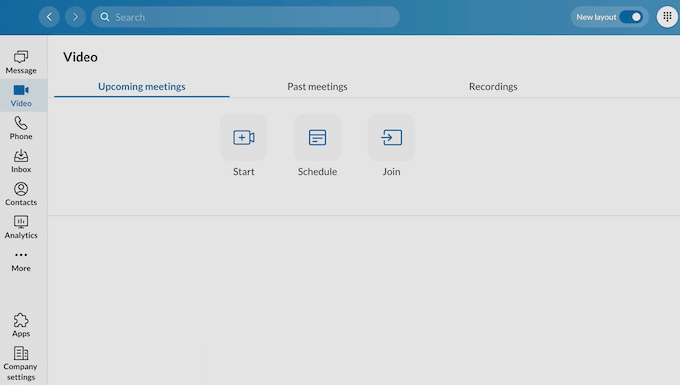
If you want to add a request-a-quote form, then you can use a plugin like WPForms. This plugin lets you create a contact form with its easy-to-use form builder.
It also has a pre-made template for quotation requests, so you don’t have to customize much.
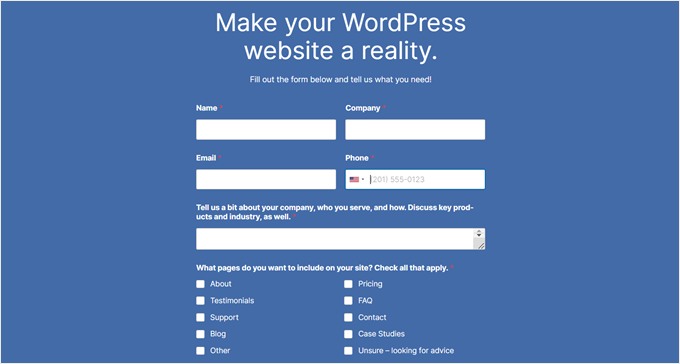
6. Build a WordPress Plugin Toolkit
As a WordPress web designer, having a collection of trusted plugins in your toolkit is like having a Swiss Army Knife for website creation.
The right plugins can streamline your workflow, add valuable features, and help you build more efficient and feature-rich websites for your clients.
Here are some essentials to get you started:
- Gutenberg blocks: The WordPress block editor offers a wide range of built-in blocks for various purposes. However, there are also several Gutenberg block plugins available that extend these features even further.
- User feedback: Consider using plugins like UserFeedback, which allow visitors to provide feedback directly on your client site’s user experience. These valuable insights can help you identify areas for improvement and test new features.
- Contact forms: Make it easy for visitors to connect with your clients by integrating a user-friendly contact form plugin.
- Pop-up forms: They are a great way to capture leads for your client’s email marketing. Choose a plugin like OptinMonster that allows for targeted pop-ups that appear at strategic moments without overwhelming visitors.
- Typography: You can add custom fonts to elevate your client’s website design.
- Sliders: Slider plugins help create dynamic presentations of images, testimonials, or other visual content.
When choosing plugins, make sure to only use ones from trusted developers or review sites like WPBeginner Solution Center.
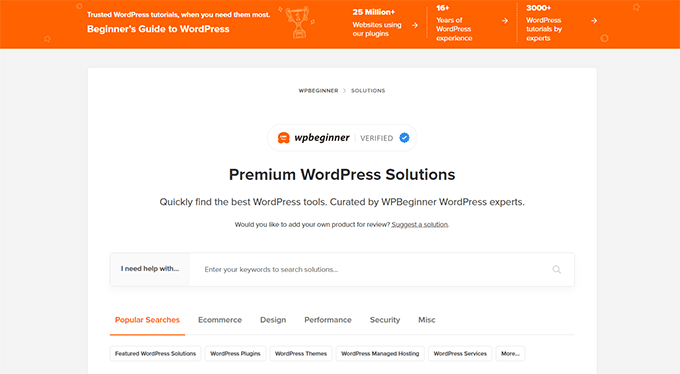
A poorly coded plugin can introduce errors, slow down performance, and ultimately lead to lost traffic and potential revenue for you and your clients.
For even more inspiration, check out our list of the must-have WordPress plugins for business websites.
7. Get Legal Advice for Your WordPress Web Design Business
Note: This does not constitute legal advice, and we are not legal professionals. We recommend discussing any contracts with your attorney or legal team before entering into any contractual agreement.
While the creative parts of web design are exciting, taking care of the legal side of your business is equally important. A solid legal foundation protects both you and your clients, creating trust and a smooth working relationship.
Here are some legal things you want to look after before starting a web design business:
- Business structure: Choosing the right business structure, whether it’s a sole proprietorship, LLC, or another option, can have significant implications for taxes, liability, and future growth.
- Clear contracts: A well-drafted contract clearly outlines the project scope, pricing, payment terms, and revision policies. This protects both you and your client by setting expectations and lowering the risk of misunderstandings.
- Business insurance: Consider investing in general liability insurance for your WordPress design business. This protects you from financial losses if a client sues you for negligence or unforeseen circumstances, such as data breaches or security issues.
Consulting a lawyer is the safest and easiest way to take care of these aspects. They can provide invaluable guidance and ensure you comply with all relevant regulations in your region.
8. Use a Project Management Software
While emails and spreadsheets can be helpful, they don’t offer the most user-friendly way to manage projects.
That’s where project or task management software comes in. These powerful tools offer a centralized platform to keep you organized, track project progress seamlessly, and ensure timely delivery.
Popular options like Asana and Monday.com allow you to create tasks, assign them to team members or yourself, set clear deadlines, and collaborate with clients in real time. This removes the back-and-forth communication struggles.
To find the perfect tool for your needs, you can explore our list of the best task management software.
9. Don’t Forget About Administrative Tasks
Efficient administrative tasks are the backbone of a smoothly running business.
Tasks like regular invoicing and bookkeeping make sure you get paid on time and can track your finances. This prevents chaos and allows you to focus on what matters most: creating exceptional websites for your clients.
Wearing many hats as a small business owner can be exhausting, but thankfully, many tools are available to automate these tasks.
For example, online bookkeeping services like Bench can help you manage your books, expenses, and taxes to keep your finances in order.
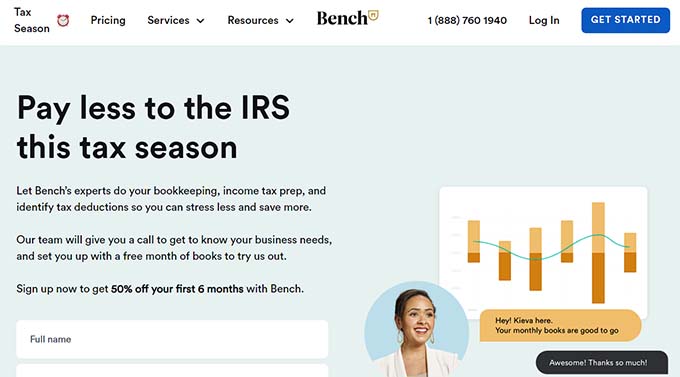
There are also accounting software options like QuickBooks to connect with your bank accounts and automatically capture all your transactions. This saves you time and removes the need for manual data entry.
If you need help with invoicing, then you can check out our guide on how to create invoices for clients using WordPress. This article will show you how to create professional invoices quickly and easily so that you get paid on time for your work.

10. Separate Business and Personal Communication
Keeping your business and personal life separate builds trust and shows that you are a serious professional.
When business and personal stuff mix, things can get confusing for everyone. Having a separate business email address and phone number keeps things clear and professional. Plus, it avoids any security risks with your personal accounts.
One way to separate professional from personal communication is to use a business email address with your own domain name. This shows that you’re a legitimate business and invest in your professional image. For more information, read our guide on how to set up a business email.
You may also want to use a professional communication tool like Slack, especially if you have team members. This keeps all your communication organized and secure in one place, and you can invite your clients to your workspace for easy collaboration.
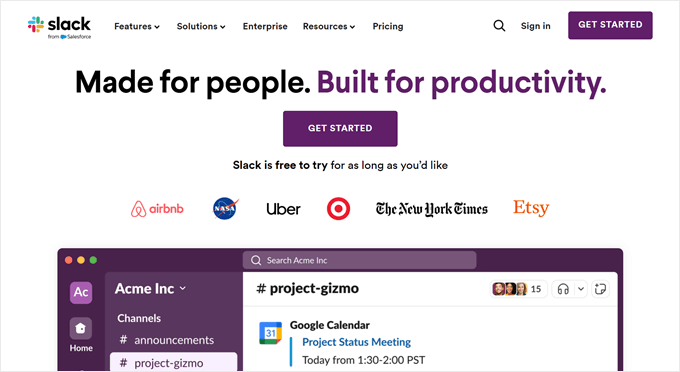
If needed, you can get a separate business phone number from Nextiva. This lets you maintain a professional presence and avoid giving out your personal phone number.
It’s also great for keeping your work and personal life separate, especially if you get many calls.
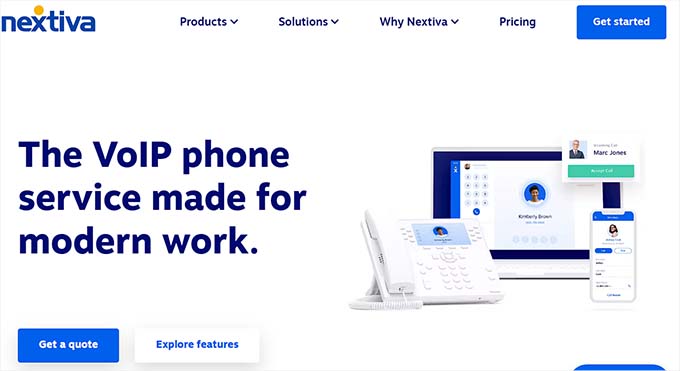
11. Establish Your Authority on Social Media
Social media is a powerful platform for professional branding and digital marketing. You can use it to connect with potential clients, showcase your expertise, and build brand awareness for your WordPress design business.
For example, graphic designer Megan Weeks uses TikTok to share her business journey and web design tips to help fellow designers. She has over 13,000 followers on the platform.

Or take a look at Mr. Web.
This YouTuber runs a web development business and shares design-related knowledge on his channel, which has over 50,000 subscribers.

Similarly, you can create social media accounts to connect with other professionals and establish yourself as an authority. You can also use them as social proof for your business.
If you’re not sure where to start, you can try choosing the social media platforms and thinking of what you want to do with them. For example, you could use YouTube for in-depth tutorials, Instagram for showcasing visual design work, or LinkedIn for professional networking.
Once you have set up your accounts, you can start creating content. Share valuable information that your target audience finds helpful. This might include showcasing your latest projects, sharing case studies, offering design tips, or answering common questions potential clients might have.
Remember to participate in online conversations and leave comments where you can add value. This is a great way to make your brand more visible and establish yourself as a thought leader in the WordPress design community.
12. Always Ask For Client Feedback
Client feedback offers valuable insights into your strengths and weaknesses.
By proactively asking for feedback after a project’s completion, you can identify areas for improvement in your communication, design process, or overall client experience. This lets you refine your approach and deliver exceptional service on every project.
What’s more, you can use your positive feedback as testimonials to display on your business website.
One way to ask for feedback is by adding a client feedback form on your website using WPForms. This lets you collect all of the feedback in one place.
Additionally, you could use the UserFeedback plugin to add a small survey feature on your client’s new website and ask for website design feedback there. This way, the client can review your work and share their thoughts while they go through the site.

13. Keep Up-to-Date With WordPress Web Design Trends
The world of web design is always changing. For your WordPress design business to succeed, you must keep yourself updated on the latest trends.
By staying current with the newest WordPress features, plugins, and security updates, you can offer your clients the best possible service.
This can mean using the latest features to create websites, picking popular themes and plugins to make sites look and work great, and following the latest security practices to keep your clients’ websites safe.
You can subscribe to the WordPress News newsletter to get information on upcoming core updates. At WPBeginner, we also share the latest WordPress news and updates to keep you in the know.
Another way to stay informed is to join online communities and forums like the WPBeginner Facebook Group. Here, you can share ideas and ask for tips and tricks from other WordPress users.
14. Consider Outsourcing or White-Labeling Services
As your WordPress design business takes off, you may find yourself with more work than you and your website development team can handle alone.
That’s where outsourcing and white-labeling services come in. These can be lifesavers for taking on bigger projects or offering new specialties to your clients.
Outsourcing lets you hand off specific tasks to talented freelancers or companies. This is a great way to find experts you need without hiring full-time staff.
On the other hand, white-labeling lets you put your own brand on services offered by another company. This way, you can provide extra perks like digital marketing services without having to become an expert yourself.
The key to both outsourcing and white-labeling is picking good partners.
If you are thinking about outsourcing, then check out WPBeginner Pro Services. We offer a bunch of services to help you manage your workload easier, from hacked site repair to site speed optimization.

For white-labeling, Seahawk Media is a great option. This WordPress company has worked with over 1000 businesses, including big-name brands like DreamHost, GoDaddy, and Alibaba Cloud.
For more information, you can check out our full Seahawk review or contact them for a free consultation.

We hope this article has helped you learn the things you should know to start a WordPress web design business. You may also want to check out our ultimate guide to editing a WordPress website and our expert pick of the best design software for WordPress.
If you liked this article, then please subscribe to our YouTube Channel for WordPress video tutorials. You can also find us on Twitter and Facebook.





Robert
Hi I just want to know regarding the domain. I work primarily in Wordpress. My client has a domain but isn’t on wordpress. How do I get them on wordpress so I can actually update their site?
WPBeginner Support
It would depend on what their site is built with currently, as an example: https://www.wpbeginner.com/wp-tutorials/how-to-properly-move-from-weebly-to-wordpress/
Admin
Kanishka sahu
Hy,
Thanks for that’s amazing knowledge
I am wordpress website design or dev I want part time job but problem isi dont know where I go for that plz help me
Thanks
Mark Smith
Thank you for the post. It will be very helpful while doing.
Felix
Wow! Thank you very much for sharing this insightful information. I am now building my own WordPress Web Design team and your information really helps a lot. I am looking for more.
– NZT Interactive
Jon Coppock
Thanks for the outline. I’m starting to develope my wordpress skill set for the very purpose of freelancing, so this article holds a lot of value fo me.
Core Overload
Great post! Two questions for you.
-How do you manage email for your clients?
-How do you manage domain registration for your clients?
Currently, the client has either registered their own domain OR needs me to do it for them. I am using BlueHost for WordPress hosting. Email I am using BlueHost right now, but I’m not exactly clear on how the hosting + email + domain registration all ties in.
Thanks!
Suraj
Nice article, much appreciated tips.
Christopher
Wow!!! Nice post. About the hosting plan you talked about, how about acting as a reseller to a hosting company, is that also okay?
WPBeginner Support
Depends on your business goals.
Admin
Easy
Thanks for the tips.
I guess they are a reminder for me, especially at this time
am thinking of starting up web design business.
Nancy Hildebrandt
This is really helpful. Would you have a recommendation on how to handle domain name registration? I’m going to explore a niche market of really small businesses who don’t really want to touch a computer. Do you advise billing them for the domain registration but make them the domain registrant?
Zimbrul
I think 3) and 5) are essential
fadhili
Great Post,
Though I’m against freshbooks as it leaves its brand name, I think you should suggest the best wordpress plugin to do this job.
Then I wonder why most clients don’t want to invest in marketing after a design is complete, some think that marketing is a part of designing!
All in all thanks for your post.
Azman Nabi
I was looking for a similar guide and then your newsletter popped up. Great timing! As I just set up my new domain for a WordPress based web design business.
And One thing, how is “DazzlingDrop.com” looks for a web design based business.